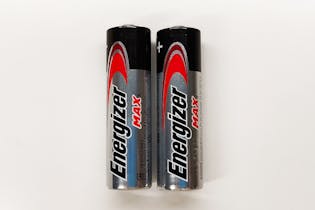Disposable AA batteries
We tested 1.5V disposable AA batteries to see which lasted longest.
There are many disposable AA battery brands and models, as well as different battery types. Battery pack sizes and claims also vary, and they range in price significantly too. So, which should you get?
Which battery for what situation?
There are three types of disposable AA batteries: lithium, alkaline and carbon zinc.
Check your device or its user manual to see which type to use. Battery packaging also often notes recommended uses, with reference to low-, moderate- and high-drain devices.
- High-drain devices include remote-controlled toys and digital cameras.
- Moderate-drain devices include torches, gaming controllers and wireless keyboards.
- Low-drain devices include wall clocks, calculators, radios and TV remotes.
Each battery type has its pros and cons.
Lithium
Good for: all situations, and better than other disposable battery types for long-term storage and use in high-drain devices, such as digital cameras and remote-controlled toys. Also ideal for cold weather use, such as with headlamps for tramping and mountaineering.
- Perform well in low-drain devices.
- Perform well to excellently in moderate- and high-drain devices.
- Perform well in extreme temperatures.
- Light weight.
- Excellent shelf life (but check expiry date).
- Won’t leak with normal use and handling.
- Very high price.
Alkaline
Good for: a wide range of applications, and ideal in low- to moderate-drain devices such as torches, gaming controllers, wireless keyboards, radios and TV remotes.
- Perform well in low and moderate-drain devices.
- Perform OK in high-drain devices.
- Some models have a good or excellent shelf life (check expiry date).
- Many models have leak protection (check packaging).
- Low priced models available.
- Heavy compared to lithium and carbon zinc batteries.
- Some models have a poor shelf life (check expiry date).
- Can eventually leak.
Carbon zinc
Carbon zinc batteries are typically labelled “heavy duty”, “super heavy duty” or “extra heavy duty”. That’s confusing as they don’t last nearly as long as other battery types.
Don’t buy: manufacturers recommend carbon zinc batteries for wall clocks, calculators, radios, TV remotes and other low-drain applications, but you’re better off using alkaline.
- Light weight.
- Many models have leak protection (check packaging).
- Low priced models available.
- Perform terribly in low-, moderate- and high-drain devices.
- Poor shelf life (check expiry date).
- Can eventually leak, and that’ll happen sooner than other battery types because they discharge quicker (whether in use or in storage).
- Some models are more expensive than alkaline.
Packaging claims
Don’t be swayed by claims that certain batteries will “last up to 400% longer”, because the small print may note “vs super heavy duty in toys”. Since “super heavy duty” refers to carbon zinc batteries, the claim might not mean a lot. We found several similar claims on the packaging of the alkaline AA batteries we tested.
Watch out for greenwashing too. The packaging of several AA batteries we investigated stated “no mercury added”, “0% mercury, 0% cadmium”, “zero added mercury or cadmium” or “no added mercury or cadmium”. However, the use of mercury in disposable AA batteries was phased out by manufacturers in the mid-1990s, and cadmium is never used in disposable AA batteries (it’s common in rechargeable AA batteries).
Did you know disposable AA batteries have an expiry date?
Although some disposable AA battery packs state a shelf life, the clock starts ticking from the date of manufacture. You won’t know how long the batteries have already been on display, so look for an expiry date.
You might have looked for it on the packaging without success – the expiry date is usually printed directly on disposable AA batteries. After this date, the batteries aren’t guaranteed to have 80% or more of their charge remaining.
Even if they’ve never been used, disposable batteries will eventually go flat. That’s why it’s better to buy only what you need rather than large packs at a discounted price.
There’s often a production date printed on disposable batteries too. With lithium, sometimes only the production date is provided.
- Lithium batteries typically have a shelf life of 10–12 years, although some manufacturers claim that certain models will last up to 20 years.
- Alkaline batteries usually have a shelf life of 5–10 years.
- Carbon zinc batteries have a shorter shelf life of 3–5 years.

How to recycle used batteries
Batteries that get thrown away in landfill can get punctured and ignite serious fires. That's why it's vital we properly recycle our used batteries.
We've tested 13 disposable aa batteries.
Find the right one for you.


